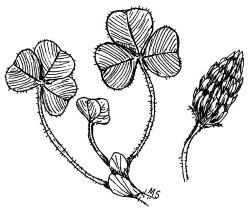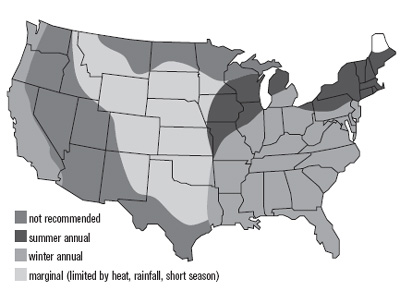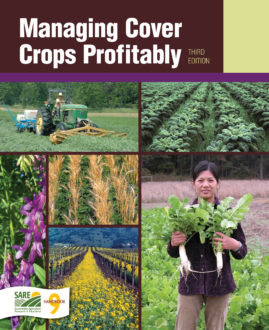Crimson Clover (Trifolium incarnatum)

Type: winter annual or summer annual legume
Roles: N source, soil builder, erosion prevention, reseeding inter-row ground cover, forage
Mix with: rye and other cereals, vetches, annual ryegrass, subclover, red clover, black medic
See charts for ranking and management summary.
With its rapid, robust growth, crimson clover provides early spring nitrogen for full-season crops. Rapid fall growth, or summer growth in cool areas, also makes it a top choice for short-rotation niches as a weed suppressing green manure. Popular as a staple forage and roadside cover crop throughout the Southeast, crimson clover is gaining increased recognition as a versatile summer-annual cover in colder regions. Its spectacular beauty when flowering keeps it visible even in a mix with other flowering legumes, a common use in California nut groves and orchards. In Michigan, it is used successfully between rows of blueberries.
Benefits of Crimson Clover Cover Crops

Nitrogen source. Whether you use it as a spring or fall N source or capitalize on its vigorous reseeding ability depends on your location. Growers in the “crimson clover zone”—east of the Mississippi, from southern Pennsylvania and southern Illinois south—choose winter annual crimson clover to provide a strong, early N boost. In Hardiness Zone 8—the warmer half of the Southeast—crimson clover will overwinter dependably with only infrequent winterkill. Its N contribution is 70 to 150 lb./A .
Reseeding cultivars provide natural fertility to corn and cotton. Crimson clover works especially well before grain sorghum, which is planted later than corn. It is being tested extensively in no-till and zone-till systems. One goal is to let the legume reseed yearly for no-cost, season-long erosion control, weed suppression and nitrogen banking for the next year.
Along the northern edge of the “crimson clover zone,” winterkill and fungal diseases will be more of a problem. Hairy vetch is the less risky overwintering winter annual legume, here and in northern areas. Crimson clover often can survive winters throughout the lower reaches of Zone 6, especially from southeastern Pennsylvania northeast to coastal New England (195).
Crimson clover is gaining popularity as a winter-killed annual, like oats, in Zones 5 and colder. Planted in late summer, it provides good groundcover and weed control as it fixes nitrogen from the atmosphere and scavenges nitrogen from the soil. Its winterkilled residue is easy to manage in spring.
Biomass. As a winter annual, crimson clover can produce 3,500 to 5,500 lb. dry matter/A and fix 70 to 150 lb. N/A by mid-May in Zone 8 (the inland Deep South). In a Mississippi study, crimson clover had produced mature seed by April 21, as well as 5,500 lb. DM and 135 lb. N/A. The study concluded that crimson clover is one of several winter annual legumes that can provide adequate but not excessive amounts of N for southern grain sorghum production (22, 36, 105). Crimson clover has produced more than 7,000 lb. DM/A several times at a USDA-ARS site in Beltsville, MD., where it produced 180 lb. N and 7,800 lb. DM/A in 1996 (412).
In field trials of six annual legumes in Mississippi, crimson clover was found to produce the most dry matter (5,600 to 6,000 lb./A) compared to hairy vetch, bigflower vetch, berseem clover, arrowleaf clover (Trifolium vesiculosum) and winter peas. It produced 99 to 130 lb. N/A and is recommended for soil erosion control because of its high early-autumn dry matter production (426).
As a summer annual in lower Michigan, a midsummer planting of crimson clover seeded at 20 lb./A produced 1,500–2,000 lb. dry matter and 50-60 lb. N/A by late November (270).
Mixtures. Crimson clover grows well in mixtures with small grains, grasses and other clovers. An oats crop is a frequent companion, either as a nurse crop to establish a clear stand of crimson clover, or as a high-biomass, nutrient-scavenging partner. In California, crimson clover is planted with rose clover and medics in orchards and nut groves to minimize erosion and provide some N to tree crops (422).
Beneficial habitat and nectar source. Crimson clover has showy, deep red blossoms 1/2 to 1 inch long. They produce abundant nectar, and are visited frequently by various types of bees. The blooms may contain many minute pirate bugs, an important beneficial insect that preys on many small pests, especially thrips (422). In Michigan, crimson increased blueberry pollination when planted in row middles. Georgia research shows that crimson clover sustains populations of pea aphids and blue alfalfa aphids. These species are not pests of pecans, but provide alternative food for beneficial predators such as lady beetles, which later attack pecan aphids.
Nutrient cycler. Crimson clover adds to the soil organic N pool by scavenging mineralized N and by normal legume N fixation. The scavenging process, accomplished most effectively by grasses, helps reduce the potential for N leaching into groundwater during winter and spring (181, 265). Mixed with annual ryegrass in a simulated rainfall study, crimson clover reduced runoff from the herbicide lactofen by 94 percent and norflurazon and fluometuron by 100 percent (346). The grass/legume mixture combines fibrous surface roots with short tap roots.
Management of Crimson Clover Cover Crops
Establishment & Fieldwork for Crimson Clover Cover Crops
Crimson clover will grow well in about any type of well drained soil, especially sandy loam. It may fare poorly on heavy clay, waterlogged, extremely acid or alkaline soils. Once established, it thrives in cool, moist conditions. Dry soil often hinders fall plantings in the South.
Inoculate crimson clover if it hasn’t been grown before. Research in Alabama showed that deficiencies of phosphorus or potassium—or strongly acidic soil with a pH of less than 5.0— can virtually shut down N fixation. Nodules were not even formed at pH 5.0 in the test. Phosphorus deficiency causes many small but inactive nodules to form (188).
Winter annual use. Seed six to eight weeks before the average date of first frost at 15 to 18 lb./A drilled, 22 to 30 lb./A broadcast. As with other winter legumes, the ideal date varies with elevation. In North Carolina, for example, the recommended seeding dates are three weeks later along the coast than in the mountains.
Don’t plant too early or crimson clover will go to seed in the fall and not regrow in spring until the soil warms up enough to germinate seeds. Early to mid-August seeding is common in the northern part of crimson clover’s winterannual range. In southern Michigan (Zone 5b - 6a) crimson clover, no-tilled into wheat stubble in mid-July, not only grew well into fall, but thrived the following spring, performing nearly as well as hairy vetch (270).
While October plantings are possible in the lower Mississippi Delta, an August 15 planting in a northern Mississippi test led to higher yields than later dates (228). In the lower Coastal Plain of the Gulf South, crimson clover can be planted until mid-November.
Nutrient release from crimson clover residue— and that of other winter annual legumes—is quicker if the cover crop is tilled lightly into the soil. Apart from erosion concerns, this fertility enhancing step adds cost and decreases the weed-suppression effect early in the subsequent crop’s cycle.
Summer annual use. In general, plant as soon as all danger of frost is past. Spring sowing establishes crimson clover for a rotation with potatoes in Maine. In Michigan, researchers have successfully established crimson clover after short-season crops such as snap beans (229, 270).
In Northern corn fields, Michigan studies showed that crimson clover can be overseeded at final cultivation (layby) when corn is 16 to 24 inches tall. Crimson clover was overseeded at 15 lb./A in 20-inch bands between 30-inch rows using insecticide boxes and an air seeder. The clover established well and caused no corn yield loss (295).Crimson clover has proved to be more promising in this niche than black medic, red clover or annual ryegrass, averaging 1,500 lb. DM/A and more than 50 lb. N/A (270).
In Maine, spring-seeded crimson clover can yield 4,000 to 5,000 lb. DM/A by July, adding 80 lb. N/A for fall vegetables. Mid-July seedings have yielded 5,500 lb./A of weed-suppressing biomass by late October. Summer-annual use is planned with the expectation of winterkill. It sometimes survives the winter even in southern Michigan (270), however, so northern experimenters should maintain a spring-kill option if icy winds and heaving don’t do the job.
In California, spring sowing often results in stunting, poor flowering and reduced seed yield, and usually requires irrigation (422).
Rotations. In the South, crops harvested in early fall or sown in late spring are ideal in sequence with crimson clover. Timely planting of crimson clover and its rapid spring growth can enable it to achieve its maximum N contribution, and perhaps reseed. While corn’s early planting date and cotton’s late harvest limit a traditional winter-annual role for crimson clover, strip planting and zone tillage create new niches. By leaving unkilled strips of crimson clover to mature between zonetilled crop rows, the legume sets seed in May. The majority of its hard seed will germinate in fall.
Kill crimson clover before seed set and use longer season cultivars where regrowth from hard seed would cause a weed problem.
Researchers have successfully strip-tilled into standing crimson clover when 25 to 80 percent of the row width is desiccated with a herbicide or mechanically tilled for the planting area. Narrower strips of crimson clover increased weed pressure but reduced moisture competition, while wider strips favored reseeding of the cover (236).
In a crimson clover-before-corn system, growers can optimize grain yields by no-tilling into the crimson clover and leaving the residue on the surface, or optimize total forage yield by harvesting the crimson clover immediately before planting corn for grain or silage (204). In Mississippi, sweet potatoes and peanuts suffered no yield or quality penalty when they were no-tilled into killed crimson clover. The system reduced soil erosion and decreased weed competition (35).
In Ohio, crimson clover mixed with hairy vetch, rye and barley provided a fertility enhancing mulch for no-till processing tomato transplants. Use of a prototype undercutter implement with a rolling harrow provided a good kill. Because the wide blades cut just under the soil surface on raised beds, they do not break stalks, thus lengthening residue durability. The long-lasting residue gave excellent results, even under organic management without the herbicides, insecticides or fungicides used on parallel plots under different management regimes. Nancy Creamer at the University of North Carolina is continuing work on the undercutter and on cover crops in organic vegetable systems (96).
Mixed seeding. For cover crop mixtures, sow crimson clover at about two-thirds of its normal rate and the other crop at one third to one-half of its monoculture rate. Crimson clover development is similar to tall fescue. It even can be established with light incorporation in existing stands of aggressive grasses after they have been closely mowed or grazed.
Reseeding. Overwintered crimson clover needs sufficient moisture at least throughout April to produce seed (130). Cultivar selection is critical when early spring maturity is needed.
DIXIE and CHIEF are full-season standards. AU ROBIN and FLAME beat them by about two weeks; a new cultivar, AU SUNRISE, is reportedly 1-3 weeks earlier; the popular TIBBEE is about a week ahead of the standards. Price varies more by seasonal supply than by cultivar.
Killing. Its simple taproot makes crimson clover easy to kill mechanically. Mowing after early bud stage will kill crimson clover. Maximum N is available at late bloom or early seed set, even before the plant dies naturally. Killing earlier yields less N—up to 50 lb. N/A less at its late vegetative stage, which is about 30 days before early seed set (342).
A rolling stalk chopper flattens a mix of crimson clover, hairy vetch and rye ahead of no-till vegetable transplanting at Steve Groff’s farm in southeastern Pennsylvania. The crimson is killed completely if it is in full bloom; and even early bloom is killed better than vegetative crimson.
Pest Management for Crimson Clover Cover Crops
Crimson clover is a secondary host to plant pests of the Heliothus species, which include corn earworm and cotton bollworm. Despite its known benefits, crimson clover has been eradicated from many miles of roadsides in Mississippi at the request of some Delta farmers who suspect it worsens problems from those pests (106).
Crimson clover doesn’t significantly increase risk of Southern corn rootworm in no-till corn, while hairy vetch does (67). It is more resistant to diseases (422) and to some nematodes than other clovers (337). Crimson clover is said to tolerate viral diseases, but it succumbed to virus in July plantings in Mississippi (228) and to Sclerotinia in fall plantings in Maryland (108).
In lab tests, crimson clover, berseem clover and hairy vetch have been shown to inhibit germination and seedling development of onion, carrot and tomato (40). However, this interference hasn’t been observed in North Carolina field crops where strips are mechanically tilled, or in other studies with crimson clover as part of a killed organic mulch. No-till vegetable transplanting has been done successfully on the same day as mechanically killing the cover crop mix on Steve Groff’s Lancaster County, Pa., farm with no negative effects.
Wait two to three weeks after killing before planting seeds, to allow the biomass to begin to decompose and the soil biological life to stabilize. During this time, a flush of pathogens such as Pythium and Rhizoctonia attack rapidly decaying plants. These pathogens also can attack seedling crops. To plant more quickly, mow the clover and use row cleaners to clear the tops from the seed zone. The mow/wait/plant cycle also may be influenced by the need to wait for rain to increase seedbed moisture.
Mixed with hairy vetch, crimson clover attracts beneficial insects, provides nitrogen and suppresses weeds in Oklahoma ’s native and plantation pecan groves. Both legumes go to seed and then are harvested for forage. Arrowleaf clover provided more biomass and N, but didn’t work as well for insect pest management and is very susceptible to root knot nematode.
Crimson clover harbors flower thrips and is a more likely host for tarnished plant bug than hairy vetch or subterranean clover (56). Intensive screenings show less abundant arthropod herbivores and predators on crimson clover than on hairy vetch (206).
Tillage practices and residue management variations (no-till, incorporate, removal) of cover cropped lupin, rye, hairy vetch or crimson clover had little consistent effect on nematodes in north Florida corn fields (264).
Other Options for Crimson Clover Cover Crops
Pasture and hay crop. Crimson clover is excellent for grazing and haying. It will regrow if grazed or mowed no lower than 3 or 4 inches before the early bud stage. Mixing with grass reduces its relatively low bloat risk even further. Timely mowing four to six weeks before bloom improves growth, reduces lodging and will cause more uniform flowering and seed ripening on highly fertile soils (120, 422).
Crimson clover can be grazed lightly in the fall, more intensively in the spring and still be left to accumulate N and/or set seed with little reduction in its soil N contribution, provided livestock are removed before flowering (80).
Comparative Notes
Crimson clover is:
- less tolerant of mowing than are subclovers or medics (422)
- similar to hairy vetch and Austrian winter pea in the Southeast for total N production
- a better weed suppressor in fall than hairy vetch
- earlier to mature in spring than hairy vetch Cultivars. See Reseeding for cultivar comparisons.
